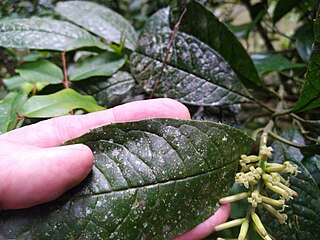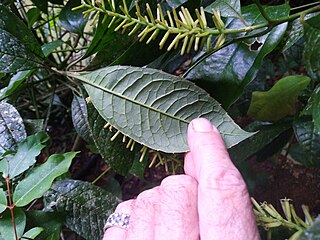| Wrinkled bark polyosma | |
|---|---|

| |
| In rainforest near Malanda, Sept 2022 | |
| Conservation status | |
| Least Concern (NCA) | |
 Least Concern (IUCN 3.1) | |
| Scientific classification | |
| Kingdom: | Plantae |
| Clade: | Tracheophytes |
| Clade: | Angiosperms |
| Clade: | Eudicots |
| Clade: | Asterids |
| Order: | Escalloniales |
| Family: | Escalloniaceae |
| Genus: | Polyosma |
| Species: | P. rhytophloia |
| Binomial name | |
| Polyosma rhytophloia C.T.White & W.D.Francis | |
Polyosma rhytophloia, commonly known as wrinkled bark polyosma, is a plant in the family Escalloniaceae which is endemic to parts of eastern Queensland, Australia. It was first described in 1926.
Description
Polyosma rhytophloia is a small evergreen tree growing up to 11 m (36 ft) high with a greenish/grey trunk measuring up to 15 cm (5.9 in) diameter. The glabrous, or hairless, leaves are elliptic to oblanceolate, with an cuneate base, an acuminate tip and a serrated margin. The lateral veins number from 6 to 12 either side of the midrib, and are conspicuous on both surfaces of the blade.
The inflorescence is a raceme (an unbranched spike) produced in the leaf axils or at the ends of branches. The cream/purple flowers are tubular, about 12 mm (0.47 in) long by 3 mm (0.12 in) wide. The fruit is a rounded or ovoid, dark purple or black berry containing a single seed. The fruit measures about 12 mm × 10 mm (0.47 in × 0.39 in) and the seed about 9 mm × 7 mm (0.35 in × 0.28 in).
Taxonomy
The wrinkled-bark polyosma was first described by the Australian botanists Cyril Tenison White and William Douglas Francis, based on specimens collected near Eungella and on the Atherton Tableland. Their paper, titled "Contributions to the Queensland Flora, No. 3", was read to the Royal Society of Queensland in 1925 and subsequently published in the Society's journal Proceedings of the Royal Society of Queensland in 1926.
Alternate spelling
In the Australian Plant Name Index, Plants of the World Online, and the IUCN Redlist, this species is treated as Polyosma rhytiphloia (note the alternate spelling in the epithet), despite it being originally published as rhytophloia. Bean & Forster argue that "The species epithet rhytophloia (meaning wrinkled bark) is derived from the Greek, and hence the correct connecting vowel is -o-".
Etymology
The genus name Polyosma is compounded from the Ancient Greek word poly meaning "many", and the Latin word osma, meaning "odour" or "smell". The species epithet rhytophloia is created from the Ancient Greek words ῥυτίς (rhutís), "wrinkle", and φλόος (phlóos), "bark".
Distribution and habitat
The native range of this species is coastal and sub-coastal ranges of eastern Queensland, from near Cooktown to the area around Eungella, west of Mackay. It grows as an understory tree in rainforest, at altitudes from about 520 to 1,300 m (1,710 to 4,270 ft).
Conservation
This species is listed by both the International Union for Conservation of Nature (IUCN) and the Queensland Government Department of Environment and Science as least concern. In support of their assessment, IUCN states that the species has a wide distribution and there are no identified threats either current or foreseen.
Gallery
References
- ^ "Species profile—Polyosma rhytophloia". Queensland Department of Environment and Science. Queensland Government. 2022. Retrieved 26 July 2023.
- ^ IUCN SSC Global Tree Specialist Group; Botanic Gardens Conservation International (BGCI) (2021). "Polyosma rhytiphloia". IUCN Red List of Threatened Species. 2021: e.T192472428A192495202. doi:10.2305/IUCN.UK.2021-1.RLTS.T192472428A192495202.en. Retrieved 19 January 2024.
- ^ "Polyosma rhytiphloia". Australian Plant Name Index (APNI). Centre for Australian National Biodiversity Research, Australian Government. Retrieved 26 July 2023.
- ^ "Polyosma rhytiphloia C.T.White & W.D.Francis". Plants of the World Online. Royal Botanic Gardens, Kew. Retrieved 26 July 2023.
- ^ White, C.T.; Francis, W.D. (1926). "Contributions to the Queensland Flora, No. 3". Proceedings of the Royal Society of Queensland. 37 (9): 152–167. doi:10.5962/p.351515. S2CID 257130421. Retrieved 27 July 2023.
- ^ Bean, A.R.; Forster, Paul I. (2021). "A taxonomic revision of Polyosma Blume (Escalloniaceae) in Australia" (PDF). Austrobaileya. 11: 89–114. doi:10.5962/p.366383. Retrieved 19 January 2024.
- ^ F.A.Zich; B.P.M.Hyland; T.Whiffen; R.A.Kerrigan (2020). "Polyosma rhytophloia". Australian Tropical Rainforest Plants Edition 8 (RFK8). Centre for Australian National Biodiversity Research (CANBR), Australian Government. Retrieved 26 July 2023.
- ^ Cooper, Wendy; Cooper, William T. (June 2004). Fruits of the Australian Tropical Rainforest. Clifton Hill, Victoria, Australia: Nokomis Editions. p. 226. ISBN 9780958174213.
- "Search: species: Polyosma rhytophloia | Occurrence records". Australasian Virtual Herbarium. Australian Government. Retrieved 27 July 2023.
External links
 Data related to Polyosma rhytophloia at Wikispecies
Data related to Polyosma rhytophloia at Wikispecies Media related to Polyosma rhytophloia at Wikimedia Commons
Media related to Polyosma rhytophloia at Wikimedia Commons- View a map of historical sightings of this species at the Australasian Virtual Herbarium
- View observations of this species on iNaturalist
- View images of this species on Flickriver
| Taxon identifiers | |
|---|---|
| Polyosma rhytophloia | |


